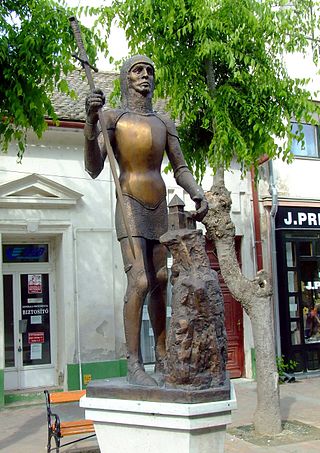Radla was a Czech priest and tutor of Saint Adalbert of Prague.

Kalocsa is a town in Bács-Kiskun county, Hungary. It lies 142 km (88 mi) south of Budapest. It is situated in a marshy but highly productive district, near the left bank of the Danube River. Historically it had greater political and economic importance than at present.

Ugrin from the kindred Csák was a Hungarian prelate and military leader in the first half of the 13th century, who served as Archbishop of Kalocsa from 1219 until his death at the Battle of Mohi on 11 April 1241. He was also chancellor of the royal court from 1217 to 1219 and from 1230 to 1235.

The Archdiocese of Kalocsa–Kecskemét is a Latin Church archdiocese of the Catholic Church in Hungary. The diocese is the metropolitan of the Diocese of Pécs and the Diocese of Szeged–Csanád. Its patron saint is Saint Paul. The current archbishop is Balázs Bábel, who was appointed in 1999.

Berthold was the count of Andechs from 1204, the archbishop of Kalocsa from 1206 until 1218, and the patriarch of Aquileia from 1218 until his death.
Blessed Sebestyén, was a Hungarian Benedictine missionary, prelate and politician, who served as Archbishop of Esztergom between 1002 and 1007.
Desiderius or Ders was a Hungarian prelate in the 11th century, who served as Archbishop of Kalocsa from around 1064 to 1076.
Macarius was a prelate in the Kingdom of Hungary in the first half of the 12th century. He was successively provost of Titel around 1127, bishop of Pécs between around 1136 and around 1139, and finally archbishop of Esztergom, until around 1147.

Mikó was a Hungarian prelate in the twelfth century. He was Archbishop of Kalocsa between around 1156 and 1165. He crowned two Hungarian monarchs, Ladislaus II and Stephen IV king, because Lucas, Archbishop of Esztergom, who considered them as usurpers, had denied to perform the ceremony.

John was a prelate in the Kingdom of Hungary in the 12th and 13th centuries. He was Bishop of Csanád between 1198 and 1201, Archbishop of Kalocsa from 1202 to 1205 and Archbishop of Esztergom between 1205 and 1223. He crowned Ladislaus III of Hungary, Andrew II of Hungary and Coloman of Halych king. Andrew II appointed him to govern the kingdom during his crusade between 1217 and 1218.
Andrew was a prelate in the Kingdom of Hungary in the second half of the 12th century. He was Archbishop of Kalocsa between 1176 and 1186, and Bishop of Győr from 1169 to 1176.

Nicholas was a 12th-century prelate in the Kingdom of Hungary. He was Archbishop of Esztergom between 1181 and 1183, and Bishop of Várad from 1163 to 1181.
Martyrius or Martirius was a Hungarian prelate in the 12th century, who served as Bishop of Veszprém from around 1127 to 1137, Bishop of Eger from 1142 to 1150, and finally Archbishop of Esztergom from 1151 until his death.
Ugrin from the kindred Csák was a Hungarian prelate at the turn of the 12th and 13th centuries, who served as Bishop of Győr from 1188 to 1204, then briefly Archbishop-elect of Esztergom in 1204.
Saul from the kindred Győr was a prelate in the Kingdom of Hungary at the turn of the 12th and 13th centuries. He was Bishop of Csanád between 1188 and 1192, then Archbishop of Kalocsa from 1192 until his death.
Stephen was a Hungarian prelate in the twelfth century, who served as Archbishop of Kalocsa in the first half of the 1170s. As one of the confidants of the pretender Géza, he strongly opposed the rule of King Béla III, who therefore deprived from his dignity in 1176.
Peter was a Hungarian prelate in the twelfth century, who served as Archbishop of Split (Spalato) from 1185 to 1190, then briefly Archbishop of Kalocsa from 1190 until his death.
Vincent was a Hungarian prelate at the turn of the 13th and 14th centuries, who served as Bishop of Syrmia till 1306, then Archbishop of Kalocsa from 1306 until his death. He supported the claim of Charles I of Hungary in his struggle for the Hungarian throne.
Elvin was a Hungarian prelate in the late 12th century, who served as Bishop of Várad from 1189 to 1200.






